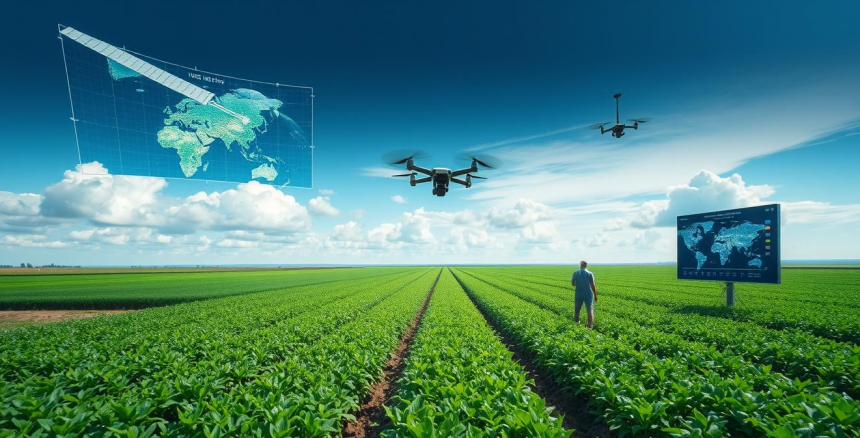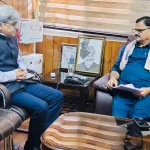Sher-e-Kashmir University of Agricultural Sciences and Technology of Kashmir (SKUAST-K) has emerged as a torchbearer in this AI-driven transformation. Recognizing the need to integrate technology with agriculture, SKUAST-K has introduced AI-focused curricula to prepare the next generation of agricultural professionals. By embedding AI into its academic and research framework, the university is fostering a culture of innovation among students and researchers alike.
One of the most remarkable initiatives is the establishment of “Discovery,” a state-of-the-art infrastructure hub designed to support high-tech agricultural innovation. This centre is equipped with advanced computing facilities, drone labs, IoT-enabled smart greenhouses, and AI research labs. It serves as a bridge between academia, start-ups, and government agencies, creating a fertile ecosystem for experimentation and entrepreneurship.
Through workshops, hackathons, and industry collaborations, SKUAST-K is exposing students to real-world applications of AI in farming. It is also playing a pivotal role in community outreach by training farmers on how to use these tools. This holistic approach—combining education, research, and field application—is what sets SKUAST-K apart as a leader in agri-tech transformation.
AI in agriculture and horticulture is not a fleeting trend; it is the future. From enhancing yield prediction and resource management to inspiring new business models and employment opportunities, AI is reshaping the rural economy. However, its true potential can only be unlocked through inclusive education, robust infrastructure, and a strong ecosystem that supports innovation at the grassroots level.
Kashmir, with its unique agricultural landscape and proactive academic institutions like SKUAST-K, stands at the cusp of a green revolution powered by algorithms and satellites rather than ploughs and oxen. As AI becomes more embedded in the agricultural DNA of the region, the dream of a self-reliant, tech-empowered, and sustainable farming ecosystem is well within reach
The 21st-century agricultural landscape is undergoing a silent revolution—one that is powered not by tractors or fertilizers, but by lines of code and artificial intelligence (AI). In a world grappling with climate change, population pressure, and limited arable land, AI is emerging as a transformative force. It is enabling more precise, sustainable, and scalable practices in agriculture and horticulture. At the heart of this revolution is a new generation of tech-savvy entrepreneurs—agripreneurs—who are harnessing AI to redefine how we grow food, manage resources, and empower rural economies.
Agripreneurship, the fusion of agriculture and entrepreneurship, is rapidly gaining momentum, and AI is its most powerful ally. By offering scalable solutions to age-old problems—such as pest control, soil management, irrigation, and crop health monitoring—AI is lowering entry barriers for young entrepreneurs in farming. These technologies are enabling more data-driven decisions, maximizing yields, and reducing input costs.
For instance, AI-driven platforms can now analyze satellite images and real-time data from IoT sensors placed in the field to predict weather conditions, detect diseases early, and suggest the best time to sow or harvest. Drones powered by AI algorithms are being used to map large farm areas, assess crop health, and spray fertilizers with remarkable precision. These tools were once limited to large corporations but are now accessible to rural start-ups and individual farmers through collaborative platforms and affordable technologies.
This wave of AI adoption is inspiring rural youth to view farming not just as labor but as a dynamic, data-centric business. Startups are sprouting across the globe that focus on AI-based agricultural consulting, precision farming tools, farm-to-market supply chain platforms, and smart irrigation systems. AI is no longer just a support system; it’s becoming the backbone of new-age Agripreneurship.
For AI to become a true enabler of Agripreneurship, capacity building is key. There is an urgent need to educate farmers, agricultural professionals, and students on how to utilize AI tools effectively. This includes training them to use machine learning models for crop forecasting, understanding drone mapping techniques, and applying data analytics for soil health monitoring.
Online and offline AI courses tailored to agriculture can empower stakeholders with hands-on skills. Governments, academic institutions, and startups need to collaborate to make AI education accessible in regional languages and formats that are easy to grasp for grassroots communities.
Moreover, integrating AI literacy into rural education and extension programs can dramatically shift the way farming is perceived. Rather than a risky and unprofitable venture, agriculture can become a tech-enabled profession with real-time decision-making, sustainable practices, and measurable results. This shift will not only increase productivity but also bring dignity, pride, and aspiration back to the farming profession.
The picturesque valley of Kashmir, known for its lush orchards, saffron fields, and horticultural diversity, is also embracing this AI-led transformation. Traditionally reliant on manual labor and seasonal cycles, agriculture in Kashmir is becoming more data-driven and efficient through the infusion of smart technologies.
New tools such as AI-powered weather prediction models, pest surveillance systems, and soil health monitoring platforms are being piloted in various districts of the Union Territory. AI is particularly crucial in horticulture, where the region’s apple and cherry orchards suffer from unpredictable climate and pest outbreaks. Now, image recognition software helps detect early signs of disease on fruit trees, while drone mapping allows for targeted application of treatments—saving both time and resources.
The terrain and climate of Kashmir, while beautiful, pose logistical challenges for farmers. AI bridges this gap by reducing the dependence on manual labour and enabling remote monitoring. Autonomous robots and unmanned vehicles are slowly entering the scene, helping with tasks like spraying, weeding, and harvesting.
Large-scale AI models can also help optimize irrigation by studying rainfall patterns and soil moisture data, a much-needed advancement in a region affected by both floods and droughts.These innovations are not only enhancing productivity but also contributing to sustainability. Reduced chemical use, efficient water management, and climate-resilient farming practices are the new norms in this emerging landscape of “smart agriculture.”
The fusion of tradition with technology is not just preserving the legacy of Kashmir’s agriculture but propelling it into a new era—one where farmers are not just cultivators, but agripreneurs; not just survivors, but innovators.
(The author is working at Ambri Apple Research Centre, Pahnoo Shopian SKUAST-K, and can be reached at: [email protected])








